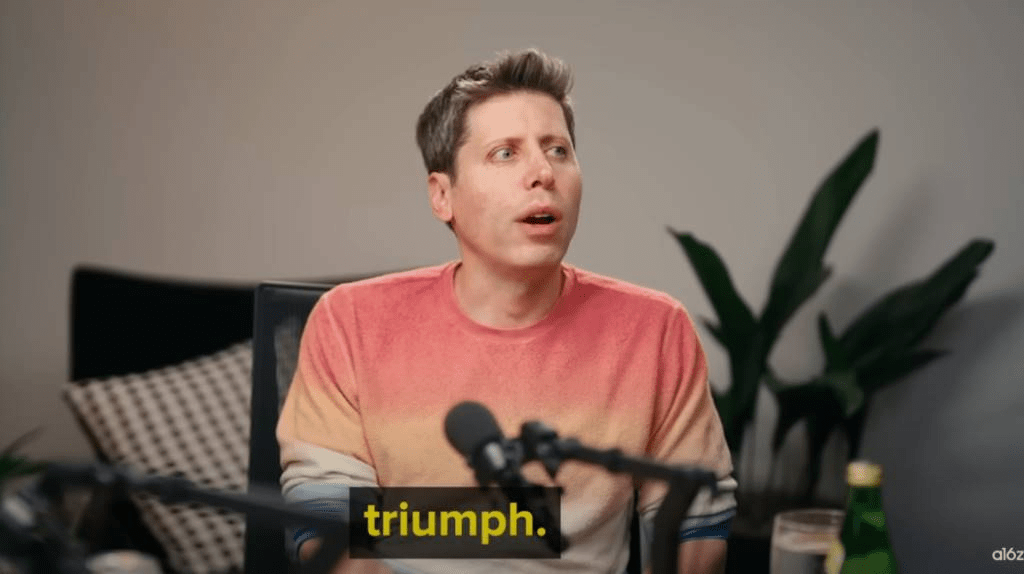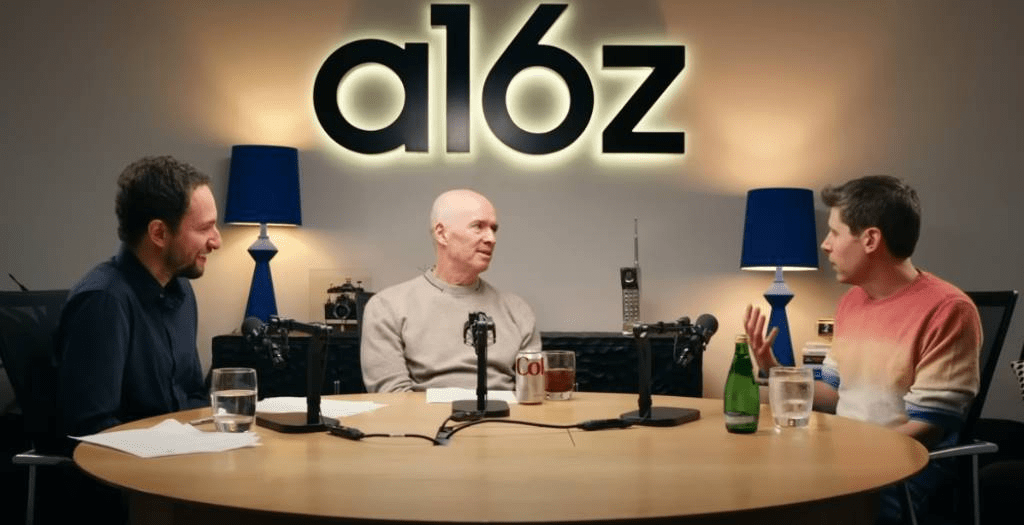Author: Long Yue
OpenAI is transforming from a research lab into a vertically integrated 'AI empire.'
On October 8, OpenAI CEO Sam Altman revealed in a recent conversation with Ben Horowitz, co-founder of the well-known venture capital firm a16z, that OpenAI has decided to make a 'very aggressive infrastructure bet' of such a scale that it requires the participation of the entire industry.
He explained that this decision is based on strong confidence in the capabilities of models in the next one to two years, as they foresee that the upcoming models will create tremendous economic value, and the current pace of expansion can no longer meet future demands.
This strategy directly explains the series of collaborations OpenAI has recently established with tech giants like NVIDIA, Oracle, and AMD. Altman announced that more such collaborations will be revealed in the coming months, indicating that they are attempting to leverage the entire industry chain from electronics to model distribution.
This may also mean that the AI race is shifting from algorithms to an all-out struggle involving computing power, capital, and energy.
Altman directly links the future of AI with the future of energy, noting that the exponential growth of AI will require cheaper, more abundant energy. He predicts that long-term solutions will be a combination of solar energy plus storage and advanced nuclear energy, asserting that the cost of nuclear energy will be a key variable in determining whether it can rapidly proliferate and subsequently support AI development.
When discussing the company's vision, Altman stated that OpenAI is not just a research lab but a composite that integrates consumer AI subscription services, large-scale infrastructure operations, and cutting-edge AI research, dedicated to building general artificial intelligence (AGI) and making it beneficial for humanity.

Key Points from Sam Altman's Interview:
Radical Infrastructure Bet: Altman revealed that the company is making a 'very aggressive infrastructure bet,' which requires the entire industry's collaborative support. This massive investment is based on strong confidence in the capabilities of models in the next one to two years, rather than current models, and he anticipates more industry collaborations in the coming months.
Blueprint for the Future of Energy: Altman pointed out that AI and energy have 'merged into one,' and the exponential growth of AI will rely on cheaper, more abundant energy. He predicts that the future of energy will be dominated by 'solar plus storage' and nuclear energy. He believes that once nuclear energy demonstrates 'overwhelming economic advantages,' its development will be extremely rapid, and he called past restrictions on nuclear energy 'an extremely foolish decision.'
Strategic Position of Sora: Sora is not only a video generation tool but also a strategic tool for building 'world models' to advance AGI and help society adapt to AI development.
'AI Scientists' Are Coming: Altman predicts that AI models will be able to make significant scientific discoveries within the next two years, which he sees as a true sign of AI changing the world. He disclosed that GPT-5 has begun to show the ability to make small, novel scientific discoveries.
Strategic Shift to Vertical Integration: Altman acknowledged that his past views on vertical integration were incorrect and now believes it is a necessary path for OpenAI to achieve its mission, comparing it to the success of the Apple iPhone.
New Copyright Models: He foresees that AI training may be viewed as fair use in the future, but using specific IP to generate content will give rise to new business models. Some copyright holders are even more concerned about their IP not being fully utilized by AI rather than being overused.
Commercialization and Trust: Regarding commercialization, Altman has an open but cautious attitude toward advertising, emphasizing that it must not undermine users' trust in ChatGPT. He believes that recommending paid products instead of the best products will destroy this trust relationship.
'A Very Aggressive Gamble': Infrastructure expansion based on future demand.
Amid current doubts about whether AI is in a bubble, Altman's statement undoubtedly adds fuel to the market's frenzy. He bluntly stated, 'We have decided that it is time to make a very aggressive infrastructure bet.'
This decision is not based on the current demand for products like ChatGPT but stems from a firm optimism about the future. Altman revealed, 'The reason we are so aggressive is not because of the existing models we have... We can see (future model capabilities) one to two years in advance.' He believes that the economic value that upcoming models will create will far exceed expectations, so early positioning is necessary.
The scale of this gamble is so enormous that it requires the entire industry's support. Altman stated, 'To wager at this scale, we kind of need the entire industry... to support it.' This encompasses 'everything from electronics to model distribution and all the links in between.'
This also explains why OpenAI is actively establishing partnerships with companies like AMD, Oracle, and NVIDIA. He hinted that this is just the beginning, stating, 'In the coming months, you should see us making more moves.'
The Lifeline of AI: The Future of Nuclear and Solar Energy.
Altman admitted that the two areas he is most concerned about in his career—AI and energy—have now 'merged into one.' He believes that looking back at history, the factor that has had the greatest impact on improving the quality of human life is cheaper and more abundant energy. The enormous computational demands of AI are pushing the energy issue to the forefront.
Regarding how to address future energy demands, Altman provided a clear roadmap. He anticipates that in the short term, new baseload energy in the United States will primarily come from natural gas. However, he believes that in the long run, 'the two dominant energies will be solar plus storage, and nuclear energy.' The nuclear energy he references includes the entire advanced nuclear technology stack, including small modular reactors (SMRs) and nuclear fusion.
Regarding the development of nuclear energy, Altman presented a key economic perspective. He believes that the speed of nuclear energy proliferation entirely depends on its cost. 'If it has overwhelming advantages economically compared to everything else, then I expect it to happen very quickly.'
He added that at that time, significant political pressure will drive regulators to act quickly. Conversely, if its costs are close to other energy sources, anti-nuclear sentiment may make its development process extremely lengthy. He candidly referred to the past decisions of many regions to ban nuclear energy as 'an extremely foolish decision.'
Strategic Value of Sora: Beyond video generation.
Regarding the recently released text-to-video model Sora, Altman also elaborated on its multiple roles in company strategy. He believes that Sora appears to be unrelated to general artificial intelligence (AGI), but he believes that building strong 'world models' is far more important for achieving AGI than people imagine.
Furthermore, Sora is also an important tool for OpenAI to guide society and technology to 'evolve together.' Altman stated that just as ChatGPT made the world take large language models seriously, Sora enables society to anticipate the impact and opportunities that powerful video models will bring. 'It's very important for the world to understand the direction of video technology development,' he said.
Of course, Sora also brings new commercialization challenges. Altman observed that users not only use it for professional creation but also for making fun memes and sharing them. The high costs of generation and the frequent use for entertainment create a contradiction, meaning OpenAI needs to explore a business model for Sora that is entirely different from ChatGPT.
Catalysts for AGI: 'AI Scientists' Are Coming.
Among all potential applications of AI, Altman expressed that he is 'most excited' about 'AI Scientists.' He believes that when AI can independently make scientific discoveries, the world will undergo real change.
'We saw small examples of it happening for the first time on GPT-5,' he revealed. He observed that the model is already able to make some novel mathematical discoveries or achieve slight progress in physics and biology research, and he believes this trend will go further.
He predicts that within the next two years, models will be able to undertake larger portions of scientific work and make significant discoveries, which will have a 'major impact' on the world.
From Investor to Operator: The Cognitive Shift Toward Vertical Integration.
During the interview, Altman also reflected on his transition from investor to company operator, and how this has influenced OpenAI's strategy. He confessed that he had always opposed vertical integration, but 'now I think I was wrong back then.'
He attributes this cognitive shift to the practical experience of running a company. As an investor, he was more inclined toward the theoretical efficiency of the market, where each company does just one thing. But as CEO, he realized that to fulfill the company's mission, he had to do more than expected. The immense success of the Apple iPhone is a prime example of extreme vertical integration, which Altman calls 'the most incredible product in the history of the tech industry.'
This shift from 'advice' to 'execution' explains why OpenAI has gradually expanded from a purely research lab to building its own large-scale infrastructure, striving to control the entire stack capability from underlying computing power to upper-level applications, laying the foundation for its grand AI empire.


